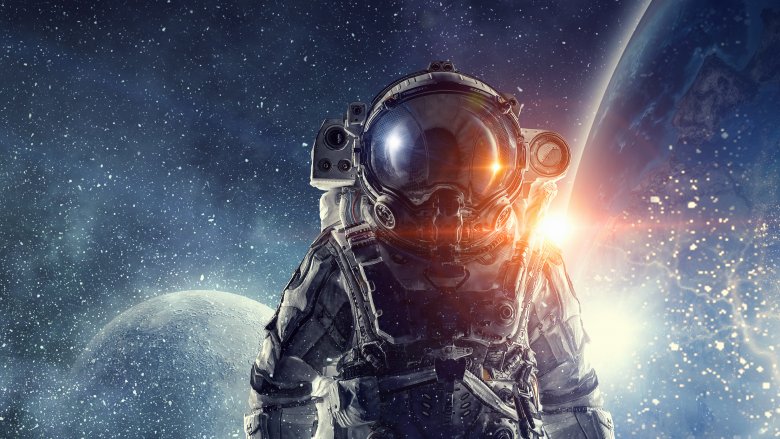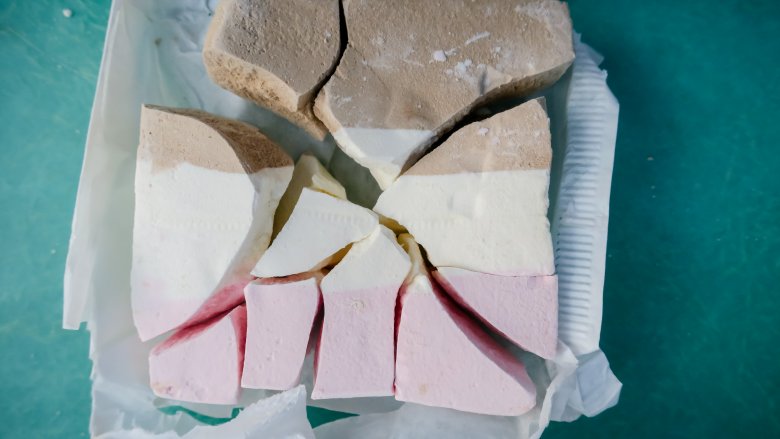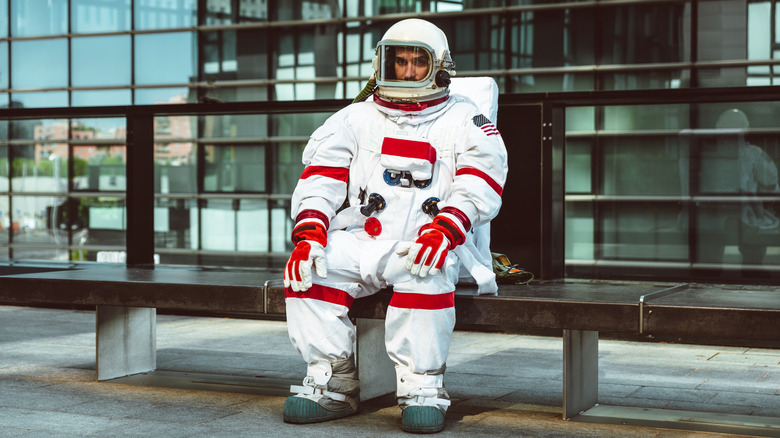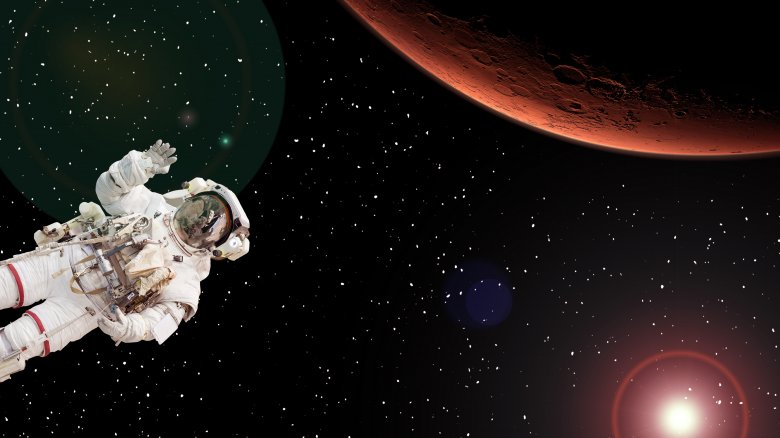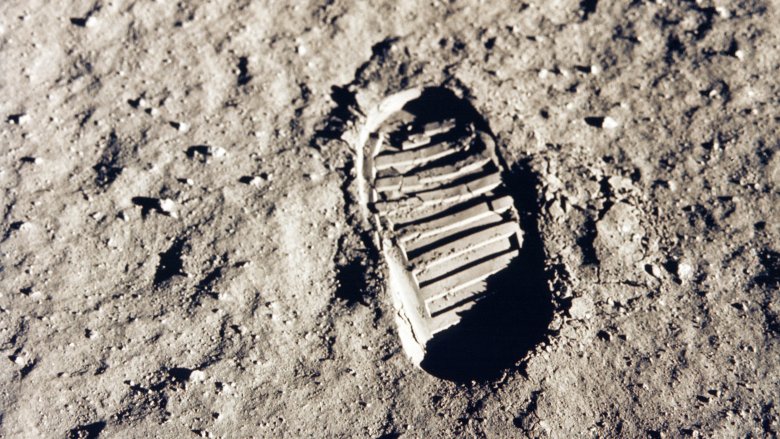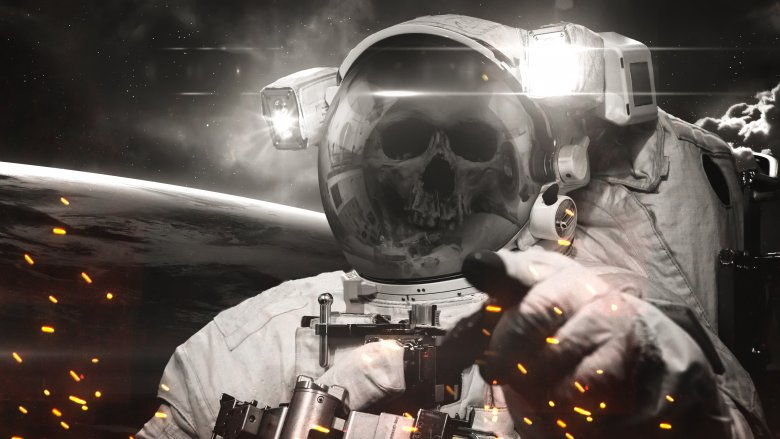False Things About Astronauts You've Been Believing
Astronauts are heroes not just to millions of school children, but to millions of adults, too, many of whom grew up watching the first Moon walk, the evolution of the space shuttle, and Elon Musk's explode-y things that he likes to call rocket ships. And as with all beloved occupations, there are rumors that become myths, myths that become legends, and a whole bunch of other things that people just make up because humans will believe almost anything.
The space program has been at the forefront of technological innovation for decades, so when you hear something about a fantastic new project or idea or discovery, it's hard not to believe it at face value. And even some of the less fantastic ideas can seem plausible, because, you know, it's NASA, and NASA has made some pretty implausible things actually happen. So the truth is we kind of all need a bit of a reality check when it comes to astronaut stuff because we wouldn't be able to die as complete humans without knowing the truth about the whole pooping-in-space thing, and some other questions of significantly lesser importance.
Astronaut ice cream was a thing
So you know that horrible freeze-dried ice cream that you pretended was awesome because it was the ice cream of the astronauts, and if you let on to the world just how awful you actually thought it was, people might think you were unpatriotic or unsupportive of the space program or not astronaut material, or whatever other unspoken reason you might have had for pretending something that tastes horrible is actually delicious? Well great news, you can stop pretending now because astronaut ice cream was never a thing.
According to C-Net, the curator of the National Air and Space Museum says that so-called astronaut ice cream never actually went to space. The company that manufactures it just told us that it did, probably because that was the only way they could convince anyone to eat the stuff. And we know this is true because Apollo 7 astronaut Walter Cunningham said it was. "They don't know their ass, obviously," Cunningham told Vox. "We never had any of that." We're not actually sure which "theys" don't know their own collective asses, but we'll definitely take his word for it.
You need serious qualifications to become an astronaut
Hollywood has told us in no uncertain terms that you have to have the right stuff to become an astronaut. An advanced university degree, 20/20 vision, a mind like a steel trap, and guts like the bear who chewed his own leg off to get out of the steel trap — these are the prerequisites for allowing NASA to put you in a tiny capsule atop more than a half million gallons of highly combustible fuel and then send you hurtling into space where let's face it, you may or may not die.
But according to NASA, you don't need to be uber-qualified to become an astronaut anymore. If you have a bachelor's degree and some relevant experience in a field like engineering, physical science, mathematics, or biological science and you can pass the physical, you can become an astronaut. If you don't have 20/20 vision that's okay, just as long as you have it surgically corrected. There's also no age restriction, no military experience required, and you don't have to be a pilot.
Now, it's not that we think NASA is maybe getting a little desperate to recruit new astronauts — surely there's no shortage of people who want to leave the comfort and security of Earth in a high-powered, potentially explosive vehicle. But doesn't it seem a little strange that the minimum qualifications are actually less than what you need to teach biology at your local community college? Just saying.
Where did we put the Earth again?
Now that NASA has put a man on the moon, it seems logical that a manned visit to our closest planetary neighbor would be next on our to-do list. That's what Elon Musk has been fussing about for all these years, and he's a billionaire so he must be an expert. But LiveScience says there's one small problem with that plan that no one has really done a good job of addressing — on a long voyage to Mars, astronauts' brains would fry like eggs on a hot sidewalk.
In 2016, President Obama wrote that one of America's goals should be "sending humans to Mars by the 2030s and returning them safely to Earth," which is a line he probably stole from Kennedy except he just replaced "Moon" with "Mars." But anyway, going to Mars is the dream of all the Elon Musk and Matt Damon fans in America, and most people think it's a given that it will one day happen. But then there's the whole "Space Brain" thing. It sounds kind of cute, like "senior moment" or "momnesia," but it actually refers to the significant and permanent brain damage caused by long-term exposure to solar and cosmic radiation. In other words, astronauts might make it to Mars, but they're likely to end up with an astronaut version of dementia, so they'd probably forget how to get home again. Tin foil hats, maybe?
Turtlenauts
Everyone wants to believe the USA was the first country to send earthlings to the Moon, except for people who don't live in the U.S. because non-Americans mostly don't give a crap one way or another. So it may or may not pain you to hear that America was not, in fact, the first nation to send earthlings to the moon. That honor belongs to the Soviet Union.
Now you'll notice that we said "earthlings," which is a category that includes humans but is not exclusively human. According to NASA, the first beings to travel to the Moon were actually turtles. Well, turtles, wine flies, mealworms, bacteria, plants, and seeds, but let's face it we only really care about the turtles. And the turtles didn't land on the Moon or anything, they just went there, flew around it, and returned to Earth.
The turtles were in remarkably good health after their journey, having lost only about 10 percent of their body weight with no loss of appetite or vigor. They were probably dissected afterward, but at least they had a nice trip. And after that happened, America went "Crap, we really can't let the Soviet Union send people to the Moon, too," so at the very least those space turtles made the ultimate sacrifice so we could stick it to the Russians. Because you know, one-upmanship is the mother of invention.
NASA has solved for space poop
The number one question people ask astronauts is not "What is it like to be weightless?" or "How does it feel to look down on our planet from 200 miles above the Earth?" Nope, Americans are way classier than that. One of the most common questions about life in space is this one: "How do you go?"
One story that did not make the history books alongside "one small step for a man" and that line Obama totally stole from Kennedy is the one about the floating turd inside the Apollo 10 command module, which astronauts had to contain with a napkin. Yes, space waste has always been a challenge for NASA, and after more than 50 years of space travel they haven't completely solved the problem. According to Space.com, modern space toilets require astronauts to use a camera to strategically line their butts up with a suction device, and if they're just a little off they might actually wreck a $19 million toilet. But there's hope for the future — some scientists think space poop might help solve the space brain problem. Would you like to hear the most brilliant idea of all time? Lining the walls of Mars-bound spacecraft with astronaut poop, which will help shield its occupants from cosmic radiation. Also, it will guarantee that hostile aliens won't come within two or three light-years of a human spacecraft, so really the awesomeness of this idea just cannot be overstated.
Space is perfectly safe
If you forget for a moment about space brain and escaping astronaut poop, there's some evidence that being in space for extended periods of is bad for you in other ways. According to Science Alert, your 20/20 eyesight (whether naturally or via laser surgery with that lid speculum thing wrenching your eyelids open) might actually vanish after long periods of time in space. Up to 80 percent of all astronauts — who have to have 20/20 vision when they leave Earth — will come back from space nearsighted.
One theory says that when you're on Earth, the water in your body is affected by gravity, but when you're in space it rises to the top of your body, which also happens to be where the important things like your brain and your eyeballs are. As many as 2 liters of fluid end up in your head, and all that fluid pushes on the backs of your eyeballs, which can permanently mess up your vision.
Oh and you might also wind up a couple inches taller (at least temporarily), so if you look good in glasses and you're sick of not being able to see over the backs of people's heads at the movies, then a career as an astronaut might be for you — just so long as you don't mind the muscle loss. And the whole camera-assisted pooping thing.
The Great Wall of Lies
The myth that you can see the Great Wall of China from space is one of the more stubborn cosmic untruths. According to The Register, first there was the often-repeated claim that astronauts could see the Great Wall of China from the surface of the Moon, which is more than 200,000 miles from Earth. "Definitely not," Neil Armstrong said so many times that he was probably almost as sick of talking about it as he was sick of answering questions about space toilets.
It's not really visible from orbit, either. Astronaut William Pogue, who incidentally wrote a book called How Do You Go to the Bathroom in Space, said he could see the Great Wall from Skylab (300 miles above the Earth) with binoculars, but that really doesn't count. Space Shuttle astronauts, who were 180 miles above the Earth, said the Great Wall was "almost invisible" because it is only 20 feet wide and is just about the same color as the natural materials surrounding it. So while it does seem rather whimsical to imagine that a structure that embodied technology and human achievement 500 years ago can be seen from a structure that embodies technology and human achievement today, it's just not true. In fact most man-made objects that are "visible from space" are really only visible with some optical assistance, unless you count entire cities at night. That's not quite as whimsical as The Great Wall of China, but we'll take it.
The million dollar space pen
If you were a space-loving kid in the '70s, you not only got blocks of disgusting freeze-dried ice cream in your Christmas stocking, you probably also got a space pen, which was extra super cool because NASA spent millions of dollars developing it and you could use it to write upside-down. Almost no one on Earth has ever had to do that, but that's not the point.
It's also not true that NASA spent millions of dollars to develop the space pen. In fact NASA says it didn't spend any money at all — rather, a guy named Paul C. Fisher spent $1 million of his own money to design a pen that would work in zero gravity, underwater, and at temperatures between -50° F and 400° F because humans often like to crawl into their ovens and write poetry while the cornbread is baking.
At first astronauts used mechanical pencils, but the problem with pencils is that lead breaks, and little pieces of pencil lead flying around in zero gravity is bad for the equipment, and it's also bad for the equipment when astronauts throw their pencils because the stupid lead keeps breaking. So in 1967, NASA agreed to buy 400 of Paul Fisher's pens for $6 each, which meant Fisher had to sell $997,600 worth of space pens before he could break even, hence the stupid things ending up in your Christmas stocking along with that disgusting astronaut ice cream.
These boots were made for Moon walking
One of the silliest astronaut myths is the one that has astronauts floating off the surface of the Moon but for their super-heavy space boots. The source of this myth seems to be some confusion about gravity, or the lack thereof in outer space — astronauts float around in the space station, so there's no gravity in space. Which means astronauts had to wear heavy boots in order to not float around when they were on the Moon.
So that's ridiculous on a couple of levels, the first being this one: If the Moon had no gravity, it really wouldn't matter how heavy your boots were, you'd still float away. And second, floating in the air is not like floating in water — extra weight doesn't make you sink. And third, that's just dumb.
According to physicist Stephanie Chasteen, people get this wrong because they use their own world experiences to make assumptions about why things happen the way they do in space. Most of us are familiar with the concept of buoyancy — if light things float in water and heavy things sink, then floating in space must be governed by similar forces. In fact, what is true is that the Moon does have gravity, it's just not as powerful as the Earth's gravity. So the astronauts didn't float away because they were held to the surface by gravity, and it had nothing to do with their footwear.
Bodies in space
When you were a kid, space was all about heroism and patriotism and Tang — no one ever told you about the mortal peril. That's because space disasters are only supposed to happen to Sandra Bullock and Matt Damon, not to real-life astronauts.
But when you stop to think about it, which you should never do, but if you did, you'd probably realize just how stupidly dangerous the whole space travel thing actually is. If modern technology can't even figure out how to build an explosion-proof cellphone battery, how could it possibly figure out how to build an explosion-proof rocket? And now that you're thinking about that, you're probably also thinking about all the astronauts who went into space and never came back. Hence all the rumors about human corpses still floating around out there somewhere.
It's a horrible thought, but it simply isn't true. According to Space.com, humans have died in space only one time in the history of manned space travel. (This doesn't count the astronauts on space shuttles that exploded during liftoff because they technically weren't in space.) In 1971, three homeward-bound Russian cosmonauts somehow managed to make a "textbook-perfect" landing even though they were all dead. Evidently the trio died after a ventilation valve ruptured, which exposed them to the vacuum of space. But thanks to the automatic re-entry program, their bodies arrived home intact and space is still blissfully free of floating human corpses.
Suicide swallow
So let's say you're aboard the Apollo spacecraft and a floating turd is headed your way. Do you chase it around with a napkin, or do you hide under a chair until one of your fellow astronauts catches it with a napkin, or do you just throw your hands up and swallow your suicide pill? It's certainly one of the most important questions of our time, but it has one fundamental flaw — astronauts do not carry and never have carried suicide pills. So escape from the floating turd will not be forthcoming.
According to RealClear Science, this rumor was probably perpetuated by astrophysicist Carl Sagan, who is mostly famous for saying the words "billions and billions" over and over again but also liked to insist that astronauts have cyanide pills on hand, just in case. Astronauts beg to differ. "I never heard of such a thing in the eleven years I spent as an astronaut and NASA executive," countered Jim Lovell in 1975. In fact, a funny thing about that — if you're going to commit suicide anyway, you might as well just expose yourself to the vacuum of space, which contrary to popular belief does not actually suck your eyeballs out of your head but rapidly puts you into a "blissful" state of unconsciousness and then kills you within a couple of minutes. Cyanide, on the other hand, is less pleasant and takes twice as long, so it's really a no-brainer.
